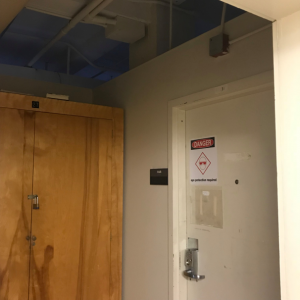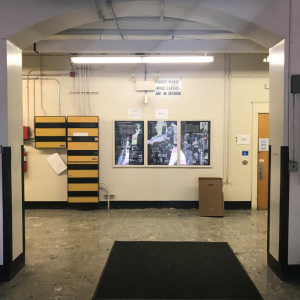By Jess Gaul
It is the height of World War I, and tensions have risen in North Carolina.
The future of UNC-Chapel Hill is uncertain as students receive on-campus military training. It hardly seems to be the time for major campus investments, let alone the construction of a permanent building.
But UNC-CH President Edward Kidder Graham is resolute — now is not the time to ignore the university’s higher purpose of learning, and classrooms are needed to meet this mission.
At his insistent pleading, the North Carolina General Assembly gives UNC-CH $500,000 toward permanent improvements at the university. The first building to appear is Phillips Hall with a bill of $138,589.78.
And with this act, the enigma of Phillips Hall begins.
Something about Phillips attracts feelings of distress among university students. Perhaps it is due to the presence of the building’s math and physics departments or the confusing navigational experience the building provides.
Designed by Charles Christian Hook, a renowned architect based in Charlotte, Phillips is a building on the cusp of collegiate gothic architecture. Its regal face and arched entryway give it a look of importance and mystery.
Phillips is named after three men in one family who each taught at the university — James, Charles and William Battle Phillips.
Exploring the interior

Throughout the dim hallways of Phillips Hall, bright red signs alerting “DANGER” cover doors and warn entrants to the possibility of hazardous materials.
Teal tiles line the tops of the hallways of the biomedical engineering labs and seem to mark the place of a time passed.
Completed in 1919, the basic structure of Phillips Hall has stood through almost 100 years of campus transformation, from racial integration to the full inclusion of women in the student body. It was home to UNC-CH’s first computer in the early 1960s.
In many ways, it feels like an old gentleman who has been shuffling slowly for way too long. Many students think it’s about time for that the old guy to take a breather.
In his calculus recitation, sophomore Evan Grimes experienced an uncomfortable atmosphere.
“It would either be ridiculously hot or ridiculously cold,” Grimes said. “It was like 85 or 87 degrees in this room. And the teacher was visibly sweating.”
“(Phillips is) an old man in the final stages of life in the nursing home.”
Phillips used to be the pinnacle of modern architecture. In its prime, it was home to male students of applied science, engineering and physics.
All in all, the face of the building is not objectively ugly. Made of stable brick and limestone, the university would likely pay millions to construct Phillips today.

Clara Schwamm, a junior math minor, first encountered Phillips Hall while on a tour of UNC-CH before entering college. Knowing her interest in math, she decided to explore the building.
She was immediately intimidated by the arched front stairway and the prominent entryway sign silencing hall dwellers – “QUIET WHILE CLASSES ARE IN SESSION.”
“It didn’t feel super welcoming,” she said.
Schwamm said she found herself questioning if she really wanted to pursue math in college.
“You walk in, and it’s immediately bleak in there,” she said. “Math is not a subject that people tend to be excited about.” And the moody vibes of the interior may not be helping things.
The not-so-modern interior of Phillips stands in stark contrast with newer, brighter buildings such as the FedEx Global Education Center on campus.
Despite its physical attributes, sophomore math major Stanley Sun has positive feelings about Phillips based on his personal experience.
“The building physically is kind of a wreck, but I love it just the same,” he said.
A native of Portland, Oregon, Sun struggled to adjust to North Carolina during his first semester. He thought of home often and was trying to make connections in his new environment
“One of my friends remarked to me that (Phillips) looked like an Oregon high school in the 50s, and that’s when I really fell in love with it,” Sun said.
After declaring his major, Sun began to make friends with people in his department and see improvements in his social and academic life.
“At that time, I felt like Phillips was my only home away from home,” he said.
A building of its time
In 1919, many students lived in north campus dorms such as Old East, Vance and Steele. Much of what is located on today’s central and south campus did not exist.
“(Student life was) just much more central in terms of the experience of the campus,” Wendy Hillis, a former historic preservation officer for UNC-CH, said. “Campus kind of ended on Cameron Avenue.” Cameron Avenue is the street that runs in front of the Old Well.
Hillis, now the university architect at Tulane University, said that it is important to understand what campus life was like in the early 20th century in evaluating Phillips’ character.
“For 100 plus years of the university’s founding … so much of the early development was on the Franklin Street quad,” she said. “It took so long to build that out.”
Across Cameron Avenue, students had meals at Swain Dining Hall, cheekily nicknamed “Swine Hall.” Education students flocked to Peabody Hall to the west of Phillips and attended commencement at the original Memorial Hall just steps to the east.
Hillis also emphasized the importance of considering the time in which Phillips was built and the transformations its walls have witnessed. It was the early 20th century when women were still not allowed to fully enroll in the university, personal computers were an unknown concept and modern comforts like air conditioning were not included.
“The way students work now and the way students learn is so different than when these buildings were built,” Hillis said.
David Owens, chair of the building and grounds committee, sat in math class on a Saturday afternoon in Phillips Hall, watching people walk to football games.
Owens said that Phillips is an older building that probably needs renovation.
“It’s just a very old building that has good bones in the sense that the basics of the building are in good shape, but the interior space is very old and tired and probably needs a significant rehab,” Owens said.
The building and grounds committee is a faculty advisory group appointed by Chancellor Folt that makes recommendations to the Chancellor about when to construct or demolish a building.
Owens said that sometimes a decision is made to keep a building due to its architectural significance, such as the Campus Y. It doesn’t match the symmetry of the rest of Polk Place, but it is important enough to the community to keep it.
“We try to renovate, rehabilitate, restore where possible,” Owens said.
Today, building plans prioritize open space, natural light and large gathering spaces. Phillips doesn’t have a lot of these characteristics because they simply weren’t a priority when it was designed.
Urban legend proclaims a blueprint mix-up between UNC-CH and another school is behind its confusing design. It is unclear whether this is true, and Owens said it is likely not the case.
The survival of Phillips
In March 2016, The Daily Tar Heel reported that a committee met to discuss the closing of Phillips based on constant complaints.
Owens says, however, that this meeting was separate from the building and grounds committee and was likely part of updates for the campus-wide master plan. The lack of word over the two years following this meeting indicates that these suggestions were not incorporated into the official university grounds plans.
Despite its physical problems, recent improvements such as new math and physics help rooms show the potential of Phillips’ interior.
Schwamm compared Phillips to Lots-o, the antagonist stuffed bear from Toy Story 3.
“It was abandoned and then became evil,” Schwamm said. “But it can be redeemed!”
Edited by Megan Cain